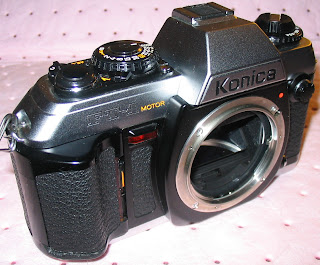Tuesday, October 9, 2012
The User's Review: Konica FT-1 Motor, Released in 1983
It is said that Konica FT-1 Motor is the first SLR camera with motor winding, and the best electrical camera body from Konica as believed by the users. FT-1 Motor also has many electrically-control functions such as self-timer, shutter cable, left-hand shutter button, single or continue shooting switch. There is also an all-black color body.
There are two kinds of battery grips for FT-1, AA-battery type and AAA-battery type as showed in the above image. These plastic-frame battery grips are not very durable and the contacts in the grips are often ruined by battery leaking.
Konica modified FT-1 to take half frame (or full frame?) picture, and this model called FT-1 Pro Half (1986) is very rare in USA.
The common issues with FT-1 are broken battery grip and non-working electrical shutter. The non-working shutter might be caused by aging connectors under the top plate. Thanks to Steven Veit who provided both words and images to show the DIY for you.
Monday, October 8, 2012
The User's Review: How to identify the flash cube types, X or N?
Before the electric flash, two types of flash cubes, each with four single-use flush bulbs, were widely used on flashes. The bulbs contain chemicals to burn and generate light. In these flashes, battery power is used to trigger the fire in the bulb.
There are two types of the flash cubes, X and N. Unfortunately, they are not compatible. Therefore, the question here is how to distinguish them. Look at the following image of them side by side:
On the bottom of X-type flash cube (left), the central hole is in a square shape and no metal wires can be seen. A sign of X is often (not always) marked on the top of X-type flash cube. On the base of N-type (right), the central hole is round and four pairs of wire as contacts (total 8) can been seen.
There are two types of the flash cubes, X and N. Unfortunately, they are not compatible. Therefore, the question here is how to distinguish them. Look at the following image of them side by side:
On the bottom of X-type flash cube (left), the central hole is in a square shape and no metal wires can be seen. A sign of X is often (not always) marked on the top of X-type flash cube. On the base of N-type (right), the central hole is round and four pairs of wire as contacts (total 8) can been seen.
Wednesday, October 3, 2012
The User's Review: Yashica 635 120/35 mm Dual-Format Twin-Lens Reflex (TLR) Camera, Released in 1958
A Yashica 635 was sold at USD 52.50 in USA on Dec. 19, 1958. Another 635 was sold at USD 81.95 and 87.60 after tax in New York in May 5, 1973, as shown on its receipt. Today it would cost 425.22 and 454.53 with tax.
Yashica 635 is a TLR camera that takes either 120 or 35 mm films via a 35 mm film kit. Not every 635 comes with the kit. You may need to buy a kit separately. Make sure that you get a total of 6 parts excluding the case in the kit.
Yashica 635 has no inboard light meter. When it is needed, I use a shoe-mounted meter with the camera.
There are two sets of lenses installed in Yahsica 635. On most 635, you will see Yashikor 80 mm 1:3.5 on both taking and viewing lenses. It says that Yashikor lens is of 3 elements. To the end of 635 production, Yahsinon 4-element 80 mm lenses were installed. However, the viewing lens has a f value of 1:2.8. Therefore, the focusing screen above Yashinon lens is brighter. There are some discussions on Yashikor and Yashinon lenses, someone said that Yashikor was sharper.
Yashica 635 has two kinds of OEM cases: The camera case holds a camera only; The kit case stores both camera and 35 mm film adapter, and has extra space for a compact flash. I saw two colors, black or brown, of the cases.
Besides several versions with changes in labels, lens and focusing screen of 635 itself, there are at least 2 or 3 versions of manual for 635. One of the versions did not provide enough info on how to use the self-timer on 635.
Yashica 635 is most related to Yashica D than any other Yashica TLRs.
Issues and Tips:
1. With aging, the self-time lever may not function properly. Some users suggest 'do not even try it, because it may block the shutter to fire'. On my 635, the self-timer lever can't be pulled all the way down some times. Even so, it will trigger the shutter. Later I found the lever problem would be solved if the flash lever was pre-set at X gear. Why? I don't know.
After reading the manuals of Yashica D and 635 that share the similar lens-shutter units, I found the right way to use the self-timer in some not all versions of the manuals. Here is how to: 1. Set the flash sync selector to X position; 2. Cock the shutter; 3. Set the self-timer; and 4. Start the timer by pressing the shutter. Caution should be given to Step 1.
2. The lower shutter speeds are not accurate on some 635.
3. A dirty viewfinder. This issue can be solved by DIY. Take off the focusing screen by unscrewing the four screws around the viewfinder assembly, and clean the screen, mirror and viewing lens properly.
Subscribe to:
Comments (Atom)

































